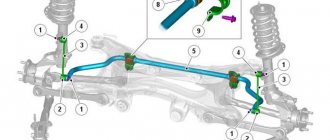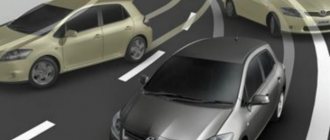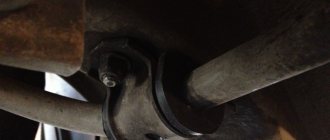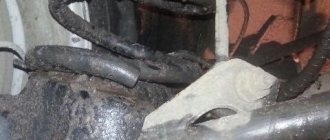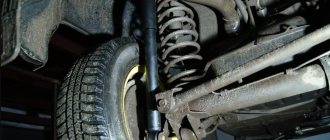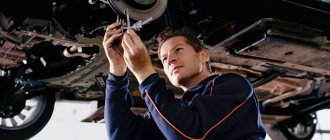A car suspension is a tricky and complex design, and every detail in it is important. If one fails, the neighboring ones begin to break down. Therefore, repairs must be done as soon as the first signs of a malfunction appear, even if they are subtle.
There are elements in the suspension that fail more often than others. These are all kinds of silent blocks and bushings, ball joints, rubber boots and bump stops, as well as stabilizer struts. The loads on the suspension are colossal, and you have to monitor the condition of its individual elements. In this article we will take a closer look at stabilizer struts.
Design and purpose of the stabilizer strut
The design of the stabilizer struts is primitive and their typical designs do not differ greatly from each other. The length of the rod, the angle of the hinges and their size, the length of the fingers are different for each car model. Sometimes silent blocks (rubber bushings) are used instead of hinges, and combined designs are also found. There are several types of traction:
- With two hinges (most common);
- With two elastic bushings (silent blocks);
- With one hinge and one bushing.
Let's consider the most popular and complex (compared to other possible) design option - with two hinges. Such “bones” consist of a rod and two hinges in the housings, liners, anthers and a rod. The main working element in the form of a standard hinge (exactly the same design for a ball joint, only larger in size) consists of:
- Ball pins;
- Boot with clamps;
- Polymer liner;
- Nuts;
- Ball housings.
The purpose of the stabilizer bar is the kinematic connection of the anti-roll bar with the shock absorber strut. The stabilizer is fixed to the subframe relatively motionless - the shock absorber strut can rotate both to the right and left (in turns), and up and down (when driving over uneven surfaces). To ensure a movable connection between the stabilizer and the shock absorber strut, the “bones” must have a certain degree of freedom; hinges or rubber bushings serve this purpose. They also fail; we will not consider cases of traction separation - this is not normal and is a manufacturing defect or the consequences of an accident.
Stabilizer link with hinges in section
Almost all modern cars come with a stabilizer, usually the front one. Less often, a rear one is additionally installed. Therefore, it is not difficult to calculate how many stabilizer struts are in the car - two or four .
Signs of failure of stabilizer struts
The main sign of wear on the stabilizer link is a metallic knock when driving over uneven surfaces. It can be confused with the knocking of a ball joint, but if the latter fails, it is usually the same one that “drums” (if the left front ball joint starts to play, the knocking will come from there). In the case of stabilizer struts, the failed right “bone” will also tap when the left wheel passes over an uneven surface , but not as loudly as on the “sick” side.
Stabilizer struts, photo dr1ver.ru
Without a trip to a diagnostic station, the best way to check your stabilizer bars is to drive out onto a gravel road. But on highways and in the city with a good asphalt surface, they may not provide comfort (with the exception of speed bumps). Off-road, if it’s really time to change the struts, they will drum properly.
Stabilizer links can also knock due to loose nuts on the pins. In some machines this is a “sore” - the problem is solved with thread lockers or cotter pins. But if you need to dismantle such a “bone” to repair other suspension components, you may not be able to do without an angle grinder.
An inspection in a pit or on a lift will confirm or refute the failure of the “bones” - in advanced cases, the hinges will knock even if you shake the racks by hand. Ball boots with cracks or tears are also a sign of the imminent death of the stabilizer struts (if they are not knocking yet, they will soon start).
Reasons for the fragility of stabilizer struts
In some cars, the struts “fly out” after 10,000 - 15,000 km. The main reasons contributing to this are:
- "Soft" metal fingers . Low-quality alloys quickly wear out and begin to play and knock;
- Poor fit of the plastic insert and the “ball” of the finger. If the “fingers” in the new stabilizer link rotate easily by hand, this is a sign of their fragility;
- Poor quality rubber boots . It tends to crack quickly and allow moisture to pass through;
- Weak boot clamps . The Chinese can easily replace metal ones with rubber ones, which are not able to ensure a tight fit of the boot, especially in winter, as a result - hello service;
- Not enough lubrication. We will not mention Chinese spare parts here - this is a problem for most manufacturers; the high price of a part is not a guarantee of quality. A drop of grease is normal (not).
- Difficult operating conditions. Regular driving on gravel roads and roads with potholes is an easy way to ruin the suspension. The “bones” are among the first to suffer.
Anti-roll bar assembly with stabilizer struts
If one of the stabilizer struts fails, it is recommended to replace both at once, because they work in pairs, and if one “dies”, the second one will soon break too.
Signs of trouble
Having understood how stabilizer links work, the driver should better study the signs of malfunctions. It is because of broken struts that loss of control can occur, which will lead to a terrible accident. The owner must be able to independently determine malfunctions.
One of the main signs of strut failure is deterioration in vehicle controllability. The driver periodically skids. Even when driving on a straight road, you need to steer. If the car deviates from the path, it will lead to an accident.
Vehicle rocking occurs due to broken struts. Rocking is felt when driving on uneven roads, when braking, turning and accelerating. If the driver ignores the symptoms for a long time, then over time he will lose control of the car.
Strange noises and sounds are the most common symptom that signals more than just broken posts. The volume of the sound depends on the speed of movement and the turning angle. For example, when driving off-road, the struts with the ball joint begin to knock. Noises usually come from the wheel arch.
If the rack design has a bushing in it, then it will be difficult to determine the malfunction. This part creaks and knocks, but the sound comes quietly. The driver often simply does not hear it, even while inside the cabin.
How to extend the life of stabilizer links
Stabilizer links on bushings can be reinforced with polyurethane silent blocks - there are companies that specialize in the production of suspension parts from this material. But there is no guarantee that you will be able to find a suitable size bushing, plus you will have to wait for delivery if there are no craftsmen in the city. Then you still need to repress it, and this usually requires special equipment.
With rods on hinges, everything is simpler and cheaper - you can extend their life (but they still won’t become eternal) with improvised tools and materials. The method is not complicated, but it requires some skill and patience. The point is to put more grease for the joints under the boot, since there is practically no grease there from the factory (one drop, as a rule). When the “ball” runs dry, its wear accelerates. A minimal amount of moisture or sand under the boot will quickly destroy the plastic liner and the hinges will rattle.
Factory lubrication of the stabilizer link (there is almost none - the finger is bare), photo dr1ver.ru
A generous amount of lubricant protects the working surface from moisture and reduces friction. Any viscous lubricant for joints will do; it is sold in every spare parts store. To get the grease under the boot, you need to bend it, to do this you need to remove one of the retaining rings - which of the two depends on the design and execution of the spare parts, it turned out to be easier for me to remove the large one, since the small one was in the form of an elastic band. You can take it off, but you may not be able to put it back on.
Factory lubrication of the stabilizer link, photo dr1ver.ru
When the boot is moved to the side, it is convenient to add lubricant. Try not to lubricate the boot seat and retaining ring - then it will be difficult to put them in place. We add lubricant without fanaticism - the excess will still be squeezed out when installing the boot in place, which will complicate reassembly.
Stabilizer link lubrication, photo dr1ver.ru
It should look something like the photo above. When assembling, you must not damage the rubber of the boot; with holes in the rubber, the stabilizer link will not last long, no matter how much lubricant there is.
Stabilizer link lubrication, photo dr1ver.ru
After lubricating one joint, we proceed to the next one and then assemble the rack back (this may be more difficult than disassembling). The first experience can be a little nervous, but with a little patience, everything will work out.
The stabilizer link is almost assembled, all that remains is to put the spring ring in place, photo dr1ver.ru
When everything is ready, you can install the rack on the car. After such manipulations, it definitely comes off more than usual. The main thing is not to “sour” your fingers - otherwise you will have to cut off the still “alive” one.
Installed stabilizer link for Rover 75. photo dr1ver.ru
It is not always possible to remove the boot - some manufacturers use special metal rings to secure them (joint to joint), which does not imply dismantling. Or they need to be snacked and exchanged for others that still need to be found. In this case, the game is not worth the candle.
High-level “Kulibins” are installed in the joint housings of grease nipples (grease fittings) to introduce grease and add it periodically. They say that this makes the parts last forever, but we haven't tested it (and don't believe it).
How to choose?
When buying racks, the driver should pay attention to:
Does the spare part match the car make? Consultants in the store, online, and product catalog will help resolve this issue.
Mount compatibility. Before proceeding with installation, you should compare the old and new parts.
Manufacturer. Every car owner has a favorite manufacturer. Based on this, you can select the appropriate part.
After purchasing, it is advisable to once again check the availability of the warranty card, as well as the quality of the product. All connecting parts, nuts, rubber bands must be in order.
Now it is possible to purchase plastic racks. They are not strong enough, but do not harm other parts of the system. Don’t forget about the length of the spare parts, and also look at the packaging, where the brands of the cars are indicated. Parts of some car brands are interchangeable. For example, the Toyota Rav 4 has an identical strut design to the Lada Vesta car. It turns out that Vesta has the opportunity to install higher quality consumables. A slight difference in length (1 cm) does not have any effect on performance.
DIY stabilizer struts
“Kulibins” of the maximum level make reinforced stabilizer struts with their own hands, usually using ammunition in the form of a “grinder” and welding. Sometimes two parts of the rack are “seated” on a threaded connection (for subsequent replacement in parts, since usually only one ball out of two is broken). We do not accept interference in the design of the car, especially in parts that affect safety. This not only negatively affects the personal safety of the “craftsman,” but also affects other road users. But let us give a few examples of so-called “collective farms”.
Homemade stabilizer rods for Skoda Octavia
Homemade stabilizer struts Mazda 323
DIY Ford Focus stabilizer bar
The effectiveness of such work has not been scientifically proven and this obviously will not make the stabilizer struts last forever. But no matter what the child amuses himself with.
Let's sum it up
Having found out what the stabilizer link is responsible for, the driver can not only recognize the problem and purchase the part, but also install it himself. Struts are considered the fastest breaking auto parts. The traction can withstand 20-80 thousand km, depending on the cost and manufacturer. The structure of the racks is also varied. They differ in the number of bushings, hinges and the specific material of manufacture. All imported parts are always made carefully and efficiently, but sometimes defects occur. To prevent the purchase of a defective product, you must check it in advance and do not forget about the warranty card.
| Tweet |
Which stabilizer links are better?
There is no ready-made recipe for choosing the best stabilizer struts; everything is individual and depends on the model and make of the car. In this case, as in general when repairing a car, the best choice is original parts, they are also called OEM. But car manufacturers rarely have their own factories to produce components; instead, they install products from specialized brands. Therefore, original parts are most often produced by premium brands, but with the logo of the car brand. The advantage of choosing original parts is that they are tested and approved by the company's engineers. The downside is the price - a part with the logo of your car brand can cost several times more than the same one, but with the emblem of the manufacturer (even if both parts were produced by the same company).
Information about who the manufacturer of certain parts in your car can be found in car enthusiast communities. With this information, you can buy the original part, but cheaper.
Stabilizer strut Stellox - there is little lubrication, but expensive brands sometimes have less, photo dr1ver.ru
In general, if you have a choice of which stabilizer struts to install, then parts from the brands Lemforder, Moog, Sasic, TRW . For "Japanese" and "Europeans" GMB . In some cars, the “bones” are consumables, so there is no point in overpaying, and you can supply ordinary Chinese spare parts from the Stellox and Patron . Sometimes they are as good as famous brands. As Metal also work well .
If the car is used mainly outside the city, you can install cheaper racks, if it is mainly off-road, city and bad roads, it is better to choose those that are more expensive, so as not to drive to service stations every 5,000 - 10,000 km.
